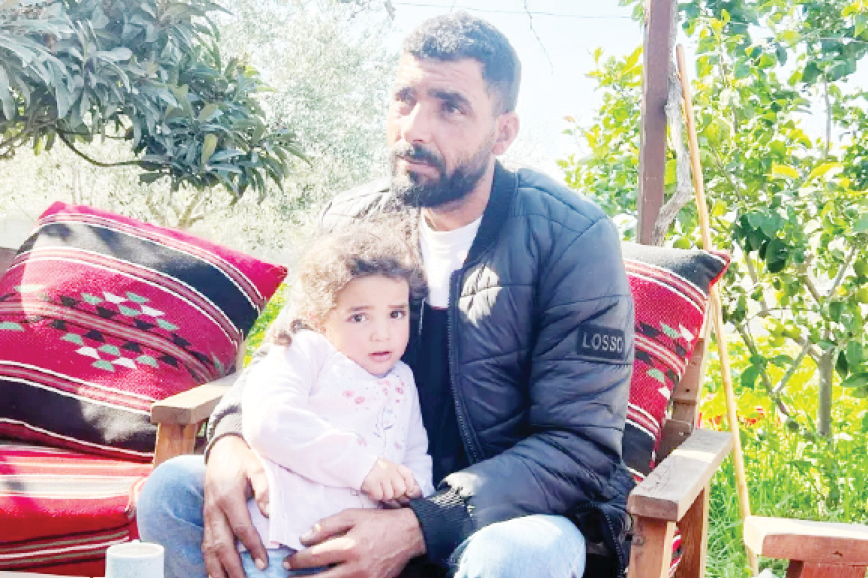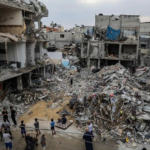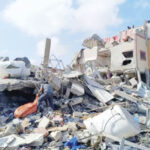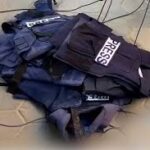Salfit, occupied West Bank – Assem Khater wants nothing more than to build a fence around his yard, to protect his three children from falling 4 metres (13 feet) into the adjacent valley while playing.
But if he does that, the 36-year-old risks the demolition of his entire two-storey house by the Israeli army in the village of Bruqin, west of Salfit city in the north of the occupied West Bank.
For the past 17 years, Israeli authorities occupying the West Bank have prohibited Khater from making any changes or additions to the home he finished building when he was 21, on private land he inherited with documentation that bears the name of his late grandfather’s father.
Khater points to the illegal Israeli settlement of Bruchin, some 400 metres (1,300 feet) away on the hill directly across from them.
The US should not worry about China-Gulf relations
Between the US and Nigeria’s elections
“In all of the world’s countries, people can own and build. But here, they [Israelis] are allowed and have the right to do so, while we – the owners of the land – do not,” said Khater.
“They come here and colonise. They are colonisers and not settlers, this is what we keep teaching our children,” he told Al Jazeera.
When Khater moved into his home in 2007 with his bride, Duaa, the Israeli military showed up on their doorstep with a “stop-work” order – a ban on making any changes to their home.
Under the pretext that his home was built without an Israeli army-issued permit in “Area C“, the 60 percent of the West Bank under exclusive Israeli military control, Israeli authorities monitored Khater’s home and the surrounding area for 17 years with constant patrols and surveillance drones. Any construction tools were confiscated and any new structures were demolished.
It was not only the authorities monitoring him, Israeli settlers from nearby illegal settlements were also empowered to watch him.
The Israeli government gives its settlers in the West Bank some 20 million shekels ($5.5m) a year to monitor, report and restrict Palestinian construction in Area C. The money is used to hire inspectors and buy drones, aerial imagery, tablets and vehicles among other things.
On April 4, Israeli authorities asked to double that amount in the state budget, to 40 million shekels ($11.1m).
“You can’t add anything to your house, at all,” said Khater. “Even tools belonging to the Palestinian government are confiscated.”
“A short while ago, Bruqin municipality employees arrived with a tractor to fix the underground water pipelines in the area. They worked on the main road, only 8 metres [26 feet] into Area C, and the army confiscated the municipality’s tractor for three months,” he continued.
In June 2022, 17 years after they moved in, the couple was shaken to find the Israeli army returning with a demolition order and a three-day grace period in which they could petition it at the Israeli High Court.
While Khater filed the petition and is awaiting a response, his home could be demolished by the Israeli army at any moment.
“Home is supposed to be the safest place for a person, yet we are constantly afraid to wake up and find them here,” said Khater.
“We sleep at 3am every day and wake up before 6am, because we expect them to come during the late night or early hours. This is how we live,” he continued.
The Khater family is one of tens of thousands in Area C of the West Bank who live in constant fear of being forced out of their homes and lands by Israel.
Israeli forces have already forcibly displaced 218 Palestinians from their homes in demolitions across Area C in the first three months of 2023, which is more than a third of the 594 Palestinians displaced there in all of 2022, according to United Nations (UN) figures.
The Israeli military has not responded to a request for comment from Al Jazeera.
The new far-right Israeli government, sworn in at the end of December, has also pushed ahead with previous plans for the forced displacement of thousands of Palestinians in the areas of Masafer Yatta and Khan al-Ahmar in Area C, as well as increased demolitions of Palestinian homes in occupied East Jerusalem.
Close to 12 percent of the Palestinian population in the West Bank currently live in Area C, about 375,000 people. While at least 46 percent of Area C is made up of private Palestinian land, less than 1 percent is accessible for Palestinian construction, and most of that is already built upon.
Area C is largely rural and comprises the only land remaining for Palestinian expansion and development. It is also the only contiguous part of the West Bank.
The presence of Israel’s illegal settlements, the separation wall, and hundreds of military checkpoints and bases have turned the West Bank into 165 disconnected Palestinian “enclaves” suffering from severe development and movement restrictions.
Meanwhile, more than 70 percent of Area C, about 44 percent of the West Bank, is used for illegal Israeli settlements and military firing zones, among other restricted areas.
The Israeli government has sought to formally annex the area after having built hundreds of illegal settlements and outposts since 1967, most of which were built either entirely or partially on private Palestinian land and are now home to about 700,000 Israeli settlers.
The settlements are a violation of international law and serve to block any potential Palestinian state being formed on the 1967-occupied territories of the West Bank, East Jerusalem and the Gaza Strip.
During the three Israeli elections in 2019 and 2020, the two largest Israeli political parties at that time – Likud and Blue and White – pledged to annex the West Bank.
The new government has been even blunter than previous ones about its intention to annex the West Bank, and to maintain Jewish dominance on both sides of what is referred to as the “Green Line”, which separates Israel and the occupied Palestinian territory on the 1949 armistice lines.
70 homes at risk
Bordering Bruqin to the southwest is the village of Kufr al-Dik where, Palestinian authorities told Al Jazeera, at least 70 homes located in Area C have had stop-work or demolition orders issued against them.
Of the 70 homes, at least 15 are threatened with imminent demolition. In the past five months, Israeli forces demolished three homes in the village.
Kufr al-Dik is squeezed between several illegal settlements and settlement industrial areas, severely restricting its ability to expand. More than 85 percent of the village is classified as Area C, whereas the rest is Area B, which is already built up.
“There are 35 homes in Kufr al-Dik that were built on lands purchased from Bruqin because there is nowhere to expand,” Mohammad Naji Odeh, head of Kufr al-Dik’s municipality, told Al Jazeera.
“People have no alternative. There is no land left in Area B – that’s why Palestinians take the risk and build homes in Area C, near the existing built-up area,” explained Odeh.
On January 10, Israeli forces demolished the two-storey home Odeh owns with his 26-year-old son Ibrahim shortly after they moved in, after four years of construction.
When the family petitioned against the demolition order, Israeli forces destroyed the home within days.
In 2018, the Israeli army issued new military orders allowing it to demolish any Palestinian home or other structures deemed “new”, within 96 hours of delivering a demolition notice.
New structures are defined as having been built within the last six months, or inhabited for less than 30 days prior to the demolition notice.
“I don’t wish this moment on anyone,” Odeh told Al Jazeera. “You feel such humiliation and contempt. Watching our years-long efforts and work, our home being demolished, while you are stuck in a car with your hands cuffed.”
“They were fascists, terrorists, in every meaning of the word,” he said.
Atmosphere of paranoia
The new Israeli government, said Odeh, has noticeably intensified enforcement of demolition orders in Area C, causing residents to panic.
In January, the Israeli army showed up at the front door of the Ahmad family in Kufr al-Dik and handed them a stop-work order, three years after they completed construction and moved in.
“We bought this piece of land and built our home with our blood, sweat and tears. We still have 60,000 shekels [about $17,000] to pay off, and now they want to demolish it?” said Fatima Ali Ahmad, a 32-year-old primary school teacher who lives in the house with her husband and four children.
“We have no one to defend us. This is systematic Israeli policy. Only God can stand in their way,” she told Al Jazeera.
On the land in front of their house, a resident from a nearby village in Salfit built a small café out of aluminium panels late last year and paid rent to the Ahmad family. The Israeli army showed up within a week and forced him to demolish it.
But the Israeli army is not the only side harassing Palestinians in Area C.
“Months ago, a settler came to my husband while he was standing outside and told him, ‘You are stealing, this is not your land.’”
“Can you imagine?” said Ahmad. “The Zionists took our land, and now they are claiming we are stealing our own land! This is the pinnacle of our suffering.”
Over the past few years, the Israeli army has been operating a hotline it calls “War Room C”, for settlers to call and report Palestinian construction in Area C.
For Palestinians, the general atmosphere of paranoia among residents has only made matters worse.
“Last week, I took out the carpets to clean inside the house. People started calling me and asking if the army is coming to demolish,” she said.
Her 65-year-old father, Fathi, chimed in, “Everyone in Kufr al-Dik has their hand on their heart – everyone is worried about their homes.”
“They [Israel] want to force Palestinians into the smallest area of land possible and to push them out of their own country. That’s it.”
Source: Al Jazeera

 Join Daily Trust WhatsApp Community For Quick Access To News and Happenings Around You.
Join Daily Trust WhatsApp Community For Quick Access To News and Happenings Around You.


